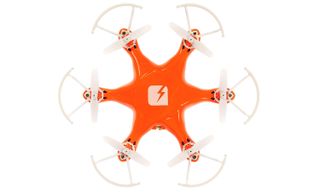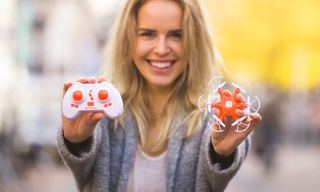TRNDLabs Skeye Hexa Drone Review
The TRNDlabs Skeye Hexa is a small, cute drone that is easy to fly and offers a few neat stunt tricks.
Why you can trust Tom's Guide

To paraphrase George Orwell, four rotors good, six rotors better. That's the idea behind the Skeye Hexa Drone, a $59 hexacopter that uses six motors and rotor blades rather than the traditional four-rotor quadcopter design. The six rotors make for more stable flight and give you more fine control over flight. The Skeye Hexa is a tough, fun mini drone to fly, with plenty of speed, good controls and a few stunt tricks up its sleeve.
Design
The Skeye Hexa is certainly distinctive, with a bright orange top and a white bottom that makes it stand out in the sky. It looks similar to the Axis Aerius, but it's larger and heavier.

The Hexa measures just 5.25 inches across (including the rotors and shields) and 1.25 inches tall. The Axis Aerius is much smaller, at about 1.25 inches wide. Four of the motor arms are decorated with green LEDs, while two red LEDs indicate the front of the craft. These are very bright: You aren't going to lose sight of this drone in the sky. Each of the small rotor blades has a small plastic shield that protects the rotor when it bumps into things, a neat idea that means you are much less prone to loosing rotor blades when you inevitably crash into the ground or a tree. You'll find the charging port on the side of the hexacopter body.
The whole thing weighs in at just more than an ounce, so it is well below the weight that requires you to register with the FAA. That is only required for drones weighing more than 0.55 pounds.
MORE: The Best Drones and Quadcopters on Any Budget
Controller
The controller is a small plastic device, about the size of a pack of cards, but fatter. It's about the same size as the controller for the similar Axis Aerius. Two control sticks on the top are the main controls: The left one handles throttle (up and down) and rotation, while the right stick moves the drone forward/back and left/right. A number of small trim buttons next to the controls can get the drone to hover. A power switch sits in the middle bottom, while a small power LED is housed on the top.
There is no automatic landing: It is all down to the pilot's skill (or lack thereof).
On the back of the controller, two shoulder buttons control the sensitivity of the sticks (left) and trigger the stunts (right). Power comes from three AA batteries that fit into a cavity on the back. You'll have to bring your own: None are included.
The 0.8-ounce controller and control sticks are a little small to fit comfortably in the hands: while my thumbs fell naturally on the control sticks, my index fingers didn't hit the shoulder buttons properly. Instead, I had to crook my fingers to trigger these buttons.

The controller and the hexacopter communicate using a 2.4-GHz signal, in the same frequency range as your Wi-Fi network. We had no problems with this interfering with Wi-Fi (or vice versa), and it worked out to a distance of about 30 feet between controller and drone. That's acceptable for a small toy drone like this, but some caution is required: if the connection is lost, the drone will keep going in whatever direction it is heading. That means the Hexa would be rather easy to lose if you are not paying attention.
Flying
To start flying, turn on both controller and drone, then flip the left stick up and down to calibrate the throttle. When successful, the lights on the controller and drone stop blinking to indicate it's ready to fly. Pushing the left stick up sends it skyward.
There is no automatic landing: It is all down to the pilot's skill (or lack thereof). The drone does have a gyroscope built in, but this mainly comes into play when the drone is doing trick moves.

The right shoulder button puts the Skeye Hexa into stunt mode: Press this and push the left stick, and the hexacopter will do a flip in the indicated direction. The hexacopter does need some room to recover, though: If it isn't at least 3 to 4 feet off the ground, it will crash as it flips. Most small drones are sometimes awkward to fly, but the Skeye Hexa is fussier than most: You need to have a very light touch on the controls to keep it stable, and it can easily tip or spin out of control if you don't react quickly enough.
The protected rotors mean that the Skeye Hexa can fly indoors. The rotors don't catch on things, and will protect both them and whatever the drone hits. The Hexa can go fast enough that it could knock something over, though: We clocked it at a healthy 12 miles per hour in flight.
If the connection is lost, the drone will keep going in whatever direction it is heading.
The left shoulder button controls the flight mode, offering three modes where the stick is more sensitive and the hexacopter can go faster. The default starter mode offers a good balance of sensitivity and speed.
Repairability
The Skeye Hexa comes with six spare rotor blades, and a tool for popping broken ones off. That's a pretty easy process. We didn't have any problems with loosing rotor blades in our tests, but they are the most commonly lost or damaged part. That's the only user-replaceable part on this hexacopter, though. You can't swap the internal battery or motors without cracking the case open. TrndLabs offers a $19 crash pack, which includes four complete sets of replacement rotor blades and replacement rotor guards.
MORE: What the FAA's Drone Rules Could Mean for You
Battery Life
The Skeye Hexa has a very small 250mAH battery built into the hexacopter body, which gives a battery life of about 6 minutes. That is definitely short, but it is on a par with other quadcopters of this type such as the Axis Aerius, which lasts for 5 minutes. You only get longer battery life from larger drones such as the $799 Parrot Bebop 2 (25 minutes).

The hexacopter recharges with the included USB cable, which takes about 30 minutes, a little longer than the similar Axis Aerius drone. Keep an eye on this cable: the end that plugs into the drone has a proprietary connector, so you can't replace it with a standard USB cable. A replacement charging cable will cost you $9.
Bottom Line
The $59 Skeye Hexa is a fun little drone ─ it is fast, both at flying straight and turning. It is a little fussy, though: You need to be quick on the controls to get it to hover and maneuver. Even on the least sensitive flying mode, it is very easy to have the Hexa fly off if you aren't paying attention. Once you get the hang of the controls, though, the Hexa is fun to fly, and can do some neat tricks for as long as the battery lasts. However, it lacks some of the cute value of its smaller cousin, the Axis Aerius, which is small enough to fit into its own controller. The Aerius is also a little easier to fly. There aren't that many advantages to having extra rotors, but the Skeye Hexa is a fun flier for both indoors and out.
Sign up to get the BEST of Tom’s Guide direct to your inbox.
Upgrade your life with a daily dose of the biggest tech news, lifestyle hacks and our curated analysis. Be the first to know about cutting-edge gadgets and the hottest deals.
Richard Baguley has been working as a technology writer and journalist since 1993. As well as contributing to Tom's Guide, he writes for Cnet, T3, Wired and many other publications.
